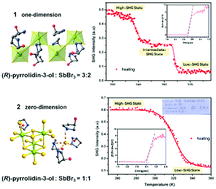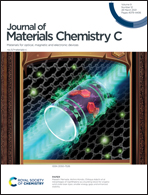Lead-free organic–inorganic hybrid semiconductors and NLO switches tuned by dimensional design†
Abstract
Nonlinear optical (NLO) switches and piezoelectric materials have drawn widespread attention benefiting from the enormous potential applications in photonic technology devices and smart sensors. Herein, we report two lead-free organic–inorganic hybrid materials, [(R)-3-hydroxy-pyrrolidinium]2SbBr5 (1) and [(R)-3-hydroxy-pyrrolidinium]5Sb4Br17 (2), in a ratio of 3 : 2 and 1 : 1 of (R)-pyrrolidin-3-ol and SbBr3, respectively. The introduction of homochiral cations ensures that 1 and 2 crystallize in non-centrosymmetric and chiral space groups, realizing the combination of piezoelectricity and second harmonic generation (SHG) properties. Moreover, the different proportions of reagents endow the two compounds with diverse structures and physical properties. Remarkably, 1 presents a novel bi-step SHG switch and demonstrates semiconductor properties with a band gap of 2.49 eV. 2 displays a SHG switch and a band gap of 3.00 eV, together with a piezoelectric response (d22 = 22 pC N−1). These findings offer a valuable way to design organic–inorganic hybrid materials combining multiple splendid physical properties and stimulate further exploration of the mutual relations between structures and physical properties.



 Please wait while we load your content...
Please wait while we load your content...